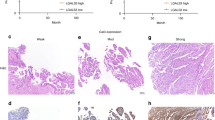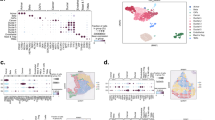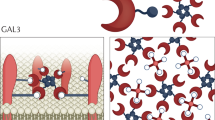Abstract
Gastric cancer ranks among the most prevalent malignancies globally, characterized by limited treatment efficacy and high recurrence rates. Effective management of this disease requires a comprehensive understanding of its underlying pathogenic mechanisms. Galectins have emerged as promising targets in gastric cancer therapy, with Galectin-9 (LGALS9) receiving considerable attention in recent years. However, Galectin-9B (LGALS9B) remains relatively under-explored in gastric cancer research. Our study investigates the role of LGALS9B in gastric cancer progression, demonstrating that its over-expression enhances cellular proliferation, migration, and invasion, while its knockdown inhibits these processes both in vitro and in vivo. We further elucidate that LGALS9B competes with the E3 ligase HERC5 for binding to eukaryotic translation elongation factor 1 delta (EEF1D), thereby preventing its protein degradation. This interaction results in the enrichment of EEF1D, which activates the PI3K/AKT signaling pathway and ultimately promotes gastric cancer progression. These findings highlight the regulatory role of LGALS9B in the pathogenesis of gastric cancer, offering valuable insights into potential novel therapeutic strategies for managing this challenging disease.
This is a preview of subscription content, access via your institution
Access options
Subscribe to this journal
Receive 50 print issues and online access
$259.00 per year
only $5.18 per issue
Buy this article
- Purchase on SpringerLink
- Instant access to full article PDF
Prices may be subject to local taxes which are calculated during checkout








Similar content being viewed by others
Data availability
All data in our study are available upon request.
References
Sung H, Ferlay J, Siegel RL, Laversanne M, Soerjomataram I, Jemal A, et al. Global Cancer Statistics 2020: GLOBOCAN estimates of incidence and mortality worldwide for 36 cancers in 185 countries. CA Cancer J Clin. 2021;71:209–49.
Hooi JKY, Lai WY, Ng WK, Suen MMY, Underwood FE, Tanyingoh D, et al. Global prevalence of Helicobacter pylori infection: systematic review and meta-analysis. Gastroenterology. 2017;153:420–9.
Mortensen K, Nilsson M, Slim K, Schäfer M, Mariette C, Braga M, et al. Consensus guidelines for enhanced recovery after gastrectomy: Ehanced Recovery after Surgery (ERAS®) Society recommendations. Br J Surg. 2014;101:1209–29.
Kim HH, Han SU, Kim MC, Kim W, Lee HJ, Ryu SW, et al. Effect of laparoscopic distal gastrectomy vs open distal gastrectomy on long-term survival among patients with stage I gastric cancer: The KLASS-01 randomized clinical trial. JAMA Oncol. 2019;5:506–13.
Bang YJ, Kim YW, Yang HK, Chung HC, Park YK, Lee KH, et al. Adjuvant capecitabine and oxaliplatin for gastric cancer after D2 gastrectomy (CLASSIC): a phase 3 open-label, randomised controlled trial. Lancet. 2012;379:315–21.
Shitara K, Özgüroğlu M, Bang YJ, Di Bartolomeo M, Mandalà M, Ryu MH, et al. Pembrolizumab versus paclitaxel for previously treated, advanced gastric or gastro-oesophageal junction cancer (KEYNOTE-061): a randomised, open-label, controlled, phase 3 trial. Lancet. 2018;392:123–33.
Johnston FM, Beckman M. Updates on management of gastric cancer. Curr Oncol Rep. 2019;21:67.
Nasr R, Shamseddine A, Mukherji D, Nassar F, Temraz S. The crosstalk between microbiome and immune response in gastric cancer. Int J Mol Sci. 2020;21:6586.
Zhang ZY, Dong JH, Chen YW, Wang XQ, Li CH, Wang J, et al. Galectin-9 acts as a prognostic factor with antimetastatic potential in hepatocellular carcinoma. Asian Pac J Cancer Prev. 2012;13:2503–9.
Kageshita T, Kashio Y, Yamauchi A, Seki M, Abedin MJ, Nishi N, et al. Possible role of galectin-9 in cell aggregation and apoptosis of human melanoma cell lines and its clinical significance. Int J Cancer. 2002;99:809–16.
Liang M, Ueno M, Oomizu S, Arikawa T, Shinonaga R, Zhang S, et al. Galectin-9 expression links to malignant potential of cervical squamous cell carcinoma. J Cancer Res Clin Oncol. 2008;134:899–907.
Strausberg RL, Feingold EA, Grouse LH, Derge JG, Klausner RD, Collins FS, et al. Generation and initial analysis of more than 15,000 full-length human and mouse cDNA sequences. Proc Natl Acad Sci USA. 2002;99:16899–903.
Oh JH, Yang JO, Hahn Y, Kim MR, Byun SS, Jeon YJ, et al. Transcriptome analysis of human gastric cancer. Mamm Genome. 2005;16:942–54.
Kimura K, Wakamatsu A, Suzuki Y, Ota T, Nishikawa T, Yamashita R, et al. Diversification of transcriptional modulation: large-scale identification and characterization of putative alternative promoters of human genes. Genome Res. 2006;16:55–65.
Dever TE. Gene-specific regulation by general translation factors. Cell. 2002;108:545–56.
Cheng DD, Li SJ, Zhu B, Zhou SM, Yang QC. EEF1D overexpression promotes osteosarcoma cell proliferation by facilitating Akt-mTOR and Akt-bad signaling. J Exp Clin Cancer Res. 2018;37:50.
Irie A, Yamauchi A, Kontani K, Kihara M, Liu D, Shirato Y, et al. Galectin-9 as a prognostic factor with antimetastatic potential in breast cancer. Clin Cancer Res. 2005;11:2962–8.
Zhang F, Zheng M, Qu Y, Li J, Ji J, Feng B, et al. Different roles of galectin-9 isoforms in modulating E-selectin expression and adhesion function in LoVo colon carcinoma cells. Mol Biol Rep. 2009;36:823–30.
Keryer-Bibens C, Pioche-Durieu C, Villemant C, Souquère S, Nishi N, Hirashima M, et al. Exosomes released by EBV-infected nasopharyngeal carcinoma cells convey the viral latent membrane protein 1 and the immunomodulatory protein galectin 9. BMC Cancer. 2006;6:283.
Mu W, Xie Y, Li J, Yan R, Zhang J, Liu Y, et al. High expression of PDZ-binding kinase is correlated with poor prognosis and immune infiltrates in hepatocellular carcinoma. World J Surg Oncol. 2022;20:22.
Wang YL, Zhang YY. cg04448376, cg24387542, cg08548498, and cg14621323 as a novel signature to predict prognosis in kidney renal papillary cell carcinoma. Biomed Res Int. 2020;2020:4854390.
Che G, Yin J, Wang W, Luo Y, Chen Y, Yu X, et al. Circumventing drug resistance in gastric cancer: a spatial multi-omics exploration of chemo and immuno-therapeutic response dynamics. Drug Resist Updat. 2024;74:101080.
Gyenis L, Duncan JS, Turowec JP, Bretner M, Litchfield DW. Unbiased functional proteomics strategy for protein kinase inhibitor validation and identification of bona fide protein kinase substrates: application to identification of EEF1D as a substrate for CK2. J Proteome Res. 2011;10:4887–901.
Shen H, Huang J, Pei H, Zeng S, Tao Y, Shen L, et al. Comparative proteomic study for profiling differentially expressed proteins between Chinese left- and right-sided colon cancers. Cancer Sci. 2013;104:135–41.
Biterge Süt B. Data article on genes that share similar expression patterns with EEF1 complex proteins in hepatocellular carcinoma. Data Brief. 2020;29:105162.
Liu K, Ren Y, Pang L, Qi Y, Jia W, Tao L, et al. Papillary renal cell carcinoma: a clinicopathological and whole-genome exon sequencing study. Int J Clin Exp Pathol. 2015;8:8311–35.
Ogawa K, Utsunomiya T, Mimori K, Tanaka Y, Tanaka F, Inoue H, et al. Clinical significance of elongation factor-1 delta mRNA expression in oesophageal carcinoma. Br J Cancer. 2004;91:282–6.
De Bortoli M, Castellino RC, Lu XY, Deyo J, Sturla LM, Adesina AM, et al. Medulloblastoma outcome is adversely associated with overexpression of EEF1D, RPL30, and RPS20 on the long arm of chromosome 8. BMC Cancer. 2006;6:223.
Xie C, Zhou M, Lin J, Wu Z, Ding S, Luo J, et al. EEF1D promotes glioma proliferation, migration, and invasion through EMT and PI3K/Akt pathway. Biomed Res Int. 2020;2020:7804706.
Fattahi S, Amjadi-Moheb F, Tabaripour R, Ashrafi GH, Akhavan-Niaki H. PI3K/AKT/mTOR signaling in gastric cancer: epigenetics and beyond. Life Sci. 2020;262:118513.
Ediriweera MK, Tennekoon KH, Samarakoon SR. Role of the PI3K/AKT/mTOR signaling pathway in ovarian cancer: Biological and therapeutic significance. Semin Cancer Biol. 2019;59:147–60.
Tian Y, Chen ZH, Wu P, Zhang D, Ma Y, Liu XF, et al. MIR497HG-derived miR-195 and miR-497 mediate tamoxifen resistance via PI3K/AKT signaling in breast cancer. Adv Sci. 2023;10:e2204819.
Funding
This work was supported by the National Natural Science Foundation of China (32370836 to Y Li), Medical Scientific Research Foundation of Guangdong Province of China (B2022168 to JB Zheng), and Guangdong Basic and Applied Basic Research Foundation (2024A1515012829 to Y Li).
Author information
Authors and Affiliations
Contributions
Huolun Feng, Wei Yao, Yucheng Zhang and Yongfeng Liu designed this study; Yucheng Zhang, Huolun Feng, Wei Yao and Ji Zhou performed the experiments; Yongfeng Liu, Bin Liu, Jiehui Li and Zhuosheng Jiang conducted RNA-Seq analyses; Fa Ling and Jianlong Zhou executed the IP-MS analysis; Huolun Feng, Deqing Wu, Yucheng Zhang and Yongfeng Liu analyzed and interpreted the data; Huolun Feng, Yucheng Zhang drafted the manuscript, Huolun Feng and Wei Yao edited the manuscript. Wei Yao, Juan Yang, Yong Li, and Jiabin Zheng provided oversight and supervision throughout this study.
Corresponding authors
Ethics declarations
Competing interests
The authors declare no competing interests.
Ethics approval and consent to participate
All methods were performed in accordance with the relevant guidelines and regulations. All animal procedures were reviewed and approved by the Animal Care and Use Committee of the Topbiotech Biotechnology Co., Ltd. SYXK 2023-0315. This work does not involve informed consent and human research.
Consent for publication
All authors have reviewed and endorsed the final manuscript, ensuring its integrity and accuracy.
Additional information
Publisher’s note Springer Nature remains neutral with regard to jurisdictional claims in published maps and institutional affiliations.
Rights and permissions
Springer Nature or its licensor (e.g. a society or other partner) holds exclusive rights to this article under a publishing agreement with the author(s) or other rightsholder(s); author self-archiving of the accepted manuscript version of this article is solely governed by the terms of such publishing agreement and applicable law.
About this article
Cite this article
Feng, H., Yao, W., Zhang, Y. et al. LGALS9B stabilizes EEF1D protein and activates the PI3K/AKT signaling pathway to promote gastric cancer occurrence and metastasis. Oncogene 44, 652–664 (2025). https://doi.org/10.1038/s41388-024-03247-2
Received:
Revised:
Accepted:
Published:
Issue date:
DOI: https://doi.org/10.1038/s41388-024-03247-2



